Live Review: Maha Music Festival 2022 (Sudan Archives, Car Seat Headrest, Indigo De Souza, Beach House)…

by Tim McMahan, Lazy-i.com
In the minds of a few folks involved in the Omaha music scene, there are two festivals this year going head-to-head — the Maha Music Festival, which happened last weekend, and Outlandia Music Festival in less than two weeks.
There is scuttlebutt, rumor and legend that Maha begat Outlandia. I’ve heard Outlandia described as a “revenge festival.” And when August comes to a close, it is inevitable that some will compare and contrast the two and declare a winner.
I won’t be one of those people. Because despite local music industry politics, I still see Maha and Outlandia as two very different animals, with two very different audiences. That doesn’t mean, however, that Outlandia didn’t impact Maha’s ticket sales.
I don’t have the numbers (yet), but my eyes tell me the crowds last weekend were among the smallest at any Maha including last year’s COVID-limited success. And in the music business as in life, size always seems to matter no matter what anyone says. Maha’s line-up, more than any in the past, was laser-targeted toward a very young demographic — not Gen X or Gen Y but squarely on the Z. And the audience reflected it – the youngest music-going audience I’ve seen at a Maha Festival. If that was their intent, congratulations.
But it was smaller. Friday night looked as if fewer than 3,000 paid ticket-goers were in attendance, though Stinson Park and the grounds surrounding it still had a festival feel, thanks to a set-up that boasted a great arcade-like area and a fun Community Village populated with energized non-profiters taking advantage of the unseasonably cool weather. Yeah, weather might be a decider between which festival was more fun to attend.
Maha’s biggest change this year was physically moving the main stage closer to the smaller second stage, and shifting the VIP area north of the main stage so VIP tents were actually visually obscured (though VIPers could still walk right down near the edge of stage left). I didn’t visit the VIP area this year because I wasn’t sure my Media Pass would let me in. (Edit: I’m now told they didn’t move the stage. It just seemed like they did because they moved the VIP area).
Realigning the private suites on the east end made the park feel smaller, tighter, which was fine considering the smaller crowd. That stage location meant concert goers were blinded as the sun fell behind either stage.
Which brings up one more positive addition — this year Maha finally added a big screen projection system, with the screen placed left of the main stage. These screens have been a staple at festivals around the country for years, and are a long time coming for Maha, obviously enhancing the experience for those seated along the walkways and in the suites. Maybe next year they can afford a second screen for the other side of the stage.
One last technical thing before we get to the music — Maha continues to be Omaha’s most well-run outdoor event thanks in huge part to their army of volunteers who help in every conceivable way, right down to helping you decide how to throw away your trash. Their volunteers have always been Maha’s greatest asset.
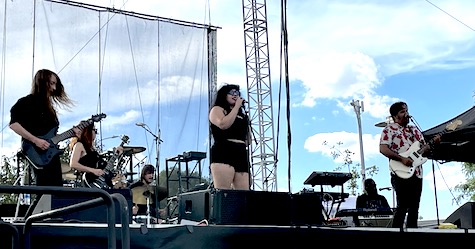
OK, onto the show. I caught the entire Friday night line-up, which kicked off right at 5:30 with punk band Las Cruxes, now boasting a ridiculous nine members. It certainly didn’t sound like nine people on the big stage, and, having seen these folks a half dozen times in the past, they could have pulled off the same performance Friday as a five-piece (though they gotta keep those two drummers).
Las Cruxes punk feels like a psych-rock concert at a blunt-instrument crime scene in a vacant apartment located somewhere just south of the boarder, say Nueva Laredo. It’s a bit unfocused, with sweeping, almost violent melodies sung in a static haze, and of course, entirely in Spanish. I have no idea what they are singing, and I’d be lying if I said the lack of translation didn’t take away from the songs. I like lyrics. If you’re uni-lingual, you’re left with only the psych-punk vibe, which by itself was potent. Punk bands typically aren’t designed for outdoor festivals, but Las Cruxes pulled it off, and I can’t wait to see them again in a club. PS: the sound mix was impeccable, Ian.
Bad Self Portraits, another local band, was next up on the small stage, which by contrast, didn’t sound much smaller. The band played their just-released EP, Fear of Missing Out, which leans more toward singer-songwriter than indie, the lead singer at times reminding me of Aimee Mann. This was the first time I’ve seen them, and probably not the best place to be introduced. It’s tough enough to get people to listen to your new album, even tougher in front of mostly empty festival grounds.
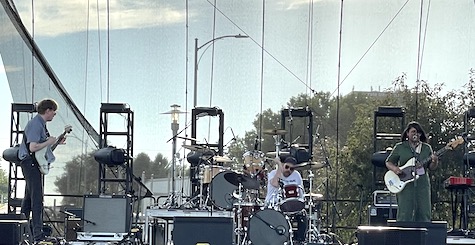
Next came the first of three touring indie acts. I hadn’t heard of Cambridge band Sweeping Promises until Maha, and wasn’t terribly inspired to check them out until: 1) local legend Jeff Runnings (of For Against fame) pointed me toward their 2020 album, Hunger for a Way Out, and 2) added that the band just got signed to Sub Pop. The aforementioned album is, indeed, awesome. Some of the innovation heard on that record was lost on stage, however. A power trio, front woman/bass player Lori Mondal’s vocals were too exposed and left hanging in the very narrow arrangements. Their performance could have benefited from a dirtier mix.
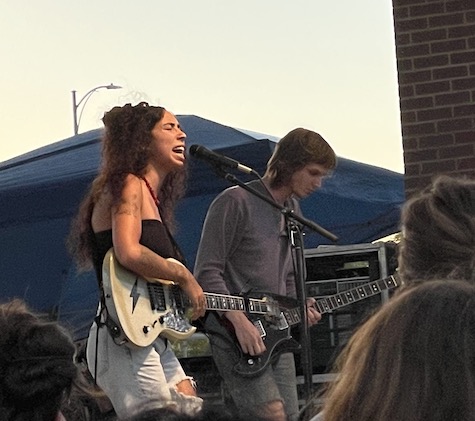
I was still waiting for the crowd to show up by 8:15 when Indigo De Souza and her band took the stage. The Saddle Creek Records act is one of the most successful new indie bands in the past couple years on the strength of two amazing albums. A small cadre of fans pressed toward the small stage, and got what they came for — a terrific set. De Souza’s between-song comments were a bit… disturbing. She said she felt cursed whenever she comes to Omaha, adding “Good luck to you.” After singing her next song she continued on about what a strange day she’d had here, and not in a good way.
But you wouldn’t have known it by her performance, which was spot on, while the small stage crowd sang along to highlight “Kill Me.” Wish more people had been there to see it.
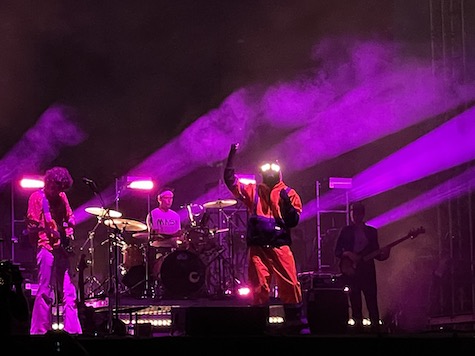
Finally at 9:30 on came Car Seat Headrest. I was at Stinson earlier that day to help set up the Union Pacific suite and caught their soundcheck, where they ended up playing most of their set. Even at the soundcheck, frontman Will Toledo wore his now trademark gas mask-with-the-glowing eyes (and floppy ears).
But whereas he wore a T-shirt and skinny jeans during soundcheck, for the actual performance he came out in his full, weird orange costume that sort of looked like a hazmat jumpsuit. He wore the mask throughout his set, a microphone tucked away either in the mask or somehow next to it (his voice sounded fine).
I’ve heard people complain that Car Seat’s performances are boring without the costume, and I disagree, but maybe it’s because I think Teens of Denial and Twin Fantasy are two of the best albums of the late 20-teens. His songwriting and arrangements are confessional and provocative, and always interesting, so I don’t need the theatrics. That said, it was was more than appropriate for headlining a festival.
Undercutting the costume, Toledo chatted with his audience and his band between songs, seemingly disconnected from the fact that he was wearing a creepy mask. The New York Times wrote about the costume, saying it was a reflection of his deep admiration for David Bowie and how he always reinvented himself. With that in mind, it’s time for Toledo to dump the costume and take on his own Thin White Duke persona.
Of the two nights, I preferred Friday. There’s talk about pumping up Maha’s Friday night line-ups, but I would keep it indie-focused and leave the big pop-fueled bands for Saturday night.
So here’s my thoughts about the Saturday events — there’s no reason to start the festival at 1:30 if you’re only going to book local bands to perform up until 5 p.m. It’s great that these bands are getting an opportunity to play on big stages, but it’s disingenuous when you consider they’re playing mainly for Maha vendors and staff. After watching a couple minutes of DJ Short-T, I split and didn’t return to the park until Geese’s set.
Maybe the biggest winner of the local bands involved was The Real Zebos. More people told me about the band than any other local on the bill (other than Las Cruxes’ colorful backstage hi-jinx). They’ve got an album release show Sept. 23 at The Slowdown.
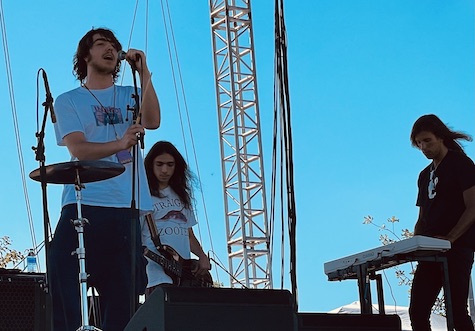
When I got back to Stinson at around 5, Geese were already on the big stage, but… without a drummer. After a few texts, I found out their drummer and guitarist were both MIA (the drummer apparently had a hand injury).
Geese was considered a huge “get” when it was announced. “Low Era,” the single off their Projector album, is on heavy rotation on Sirius XMU and has a cool vibe reminiscent of early Tame Impala. Of course we got none of that Saturday as the band ended up doing a free-form set that sounded more like noodling than anything else (I was reminded of the Jazz Odyssey scene in Spinal Tap). They were apologetic throughout, and it was a good effort to make the most of a bad situation, but I was just waiting for them to wrap it up. We still haven’t seen Geese.
Things went from bad to worse, as Sudan Archives were tortured with technical problems on that small stage. I was standing just right of the stage as frontwoman Brittney Parks struggled to get her violin pick-up to work, talking back and forth with the stage sound dude. She would plug things in, unplug and replug and the stage sound guy would say “Nothing” or “I have one channel now.” This went on and on and the schedule looked to be blown.
And then, out of the blue, two other performers went on the small stage, unscheduled, and played a couple songs that I will only describe as… challenging. I was beginning to think we weren’t going to get Sudan Archives at all.
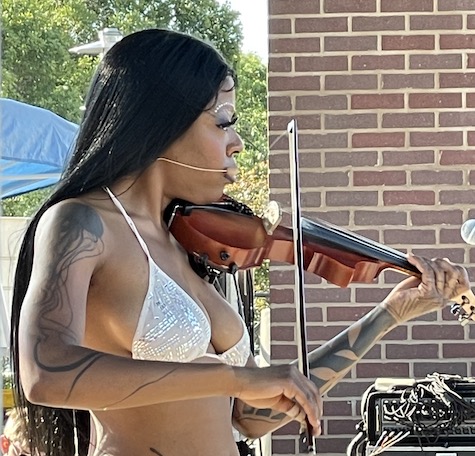
As 6 p.m. rolled around (15 minutes late), they finally introduced Sudan Archives, who played as a duo, with a guy manning a laptop/synth/beatbox. The first song went fine, but then 30 seconds into the next song, the amps erupted in static, and the sound was cut. I thought for sure the set was over, when Parks picked up her violin, said “I’m just going to plug this in direct” and began playing a stripped down version of one of her songs, using a pedal repeater, the beat box and her vocals. It was amazing.
By the time that song finished, the tech problem was worked out, but time had run out. Maha wisely let them go on, and we got stunning versions of “NBPQ (Topless)” whose chorus is “I just want to have my titties out, titties out, titties out,” and breakout single “Selfish Soul.” What could have been a disaster ended up one of the best sets of the festival. Sudan Archives will be that act who, in a couple years when she’s playing huge audiences, we’ll say, “I remember when she played Maha.”
Things went pretty smoothly after that.
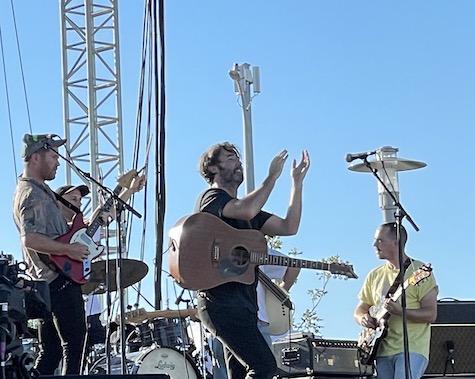
Rolling Blackouts Coastal Fever came on maybe five minutes late, so things were getting back on schedule. A huge Australian act, they could headline most any other mid-size festival, and were a great late pick-up for Maha. They played with absolute precision their hits, including the ubiquitous “Talking Straight.” I’m not a big fan of this band — the music is a bit too mainstream for me. In a few years, this will be prime Dad Rock material (Outlandia, take note), but I know a lot of people love them, and they got exactly what they came for.
Every year, Maha has one earlier-in-the-day act that ignites the crowd. A few years back, for example, it was Atmosphere. This year it was PUP.
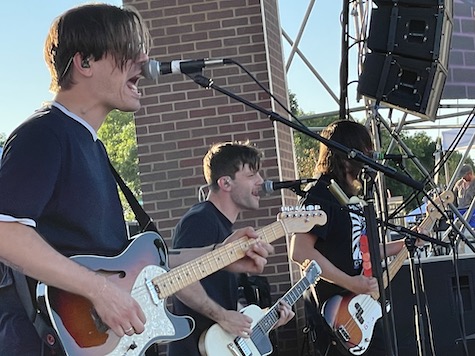
The emo-punk band said the festival was the last gig on their world tour, and you could tell. They’re the kind of band with rabid fans who sing along to every song. A fairly large mosh pit formed in front of the stage as kids bounced around into each other more like pogo moshing than slam dancing. PUP’s music isn’t dark, gritty or hardcore; it’s more like pop punk with emo at its center, extremely well played, and the kids loved it.

They were a huge contrast to Princess Nokia, a red-hot New York-born Puerto Rican MC, singer and performer. She had literally just flown in for the performance (or so she said), and it took her awhile to get comfortable on stage, using her opening song as her sound check. Backed by her DJ, she ran through her a set along with a few a cappella raps and a ton of between-song messaging about social issues, equality, and not taking shit from anyone. At one point she invited the people of color to come up front. I thought her arrangements and DJ were solid; her rhyme and flow, not so much.
By the end of her set, the crowd size looked somewhat impressive, but nowhere near as big as past years’ closing nights. We’ll see what the numbers say, but I think the data will prove this to be an off year for Maha. Part is due to the headliner choice. Beach House is far from a household name unlike past Maha headliners like Weezer, Lizzo, Garbage, Run the Jewels, etc. If you think Maha should continue to cater to indie (as I do), then you’re OK with that.
Beach House is a top-drawer indie band, but they’re not a huge draw, like festival headliners that Maha may never attract because of cost or scheduling, such as The Smile (ex-Radiohead), Tame Impala, LCD Soundsystem, Arcade Fire, Lana Del Rey, IDLES, Fontaines D.C., Wet Leg, and yeah, apparently Phoebe Bridgers (but that’s another story).
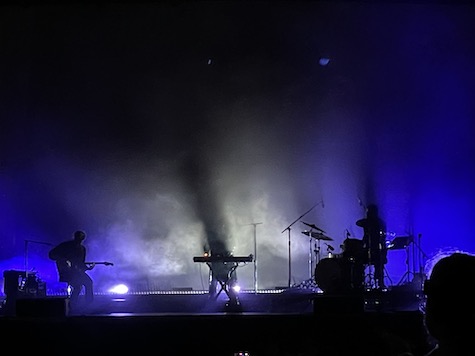
Beach House used a solid backdrop to facilitate a huge projection system throughout their performance, effectively setting a tone that complimented their spacey, droning indie music. Like last year’s Khruangbin headliner, it made for a laid-back closing act, but as I’ve said before, I never go to Maha for the headliner and never stay til the end.
So, another successful Maha Festival in the books, certainly in terms of execution and artistry. Maha continues to have the most diverse line-up of any local festival. And their hospitality is flawless, especially with those volunteers. Still, there’s always room for improvement, like getting a second big screen and it’s high time they hire an event DJ to keep the vibe flowing between sets.
Maybe the best thing about Maha is that it’s so damn easy. I rode my motorcycle to the park and walked right into the festival — zero hassle. The location and convenience are unmatched (and that’s something that may be lost if/when Maha makes its eventual move to downtown Omaha).
And while Outlandia may have bigger names in their line-up — ultimately drawing a larger audience — the jury is out as to how they’ll funnel a ginormous audience into Falconwood Park, with its access via a two-lane road and $25 on-site parking. I’m confident they have all that figured out, right? We’ll find out in less than couple weeks…
* * *
Read Tim McMahan’s blog daily at Lazy-i.com — an online music magazine that includes feature interviews, reviews and news. The focus is on the national indie music scene with a special emphasis on the best original bands in the Omaha area. Copyright © 2022 Tim McMahan. All rights reserved.

Recent Comments